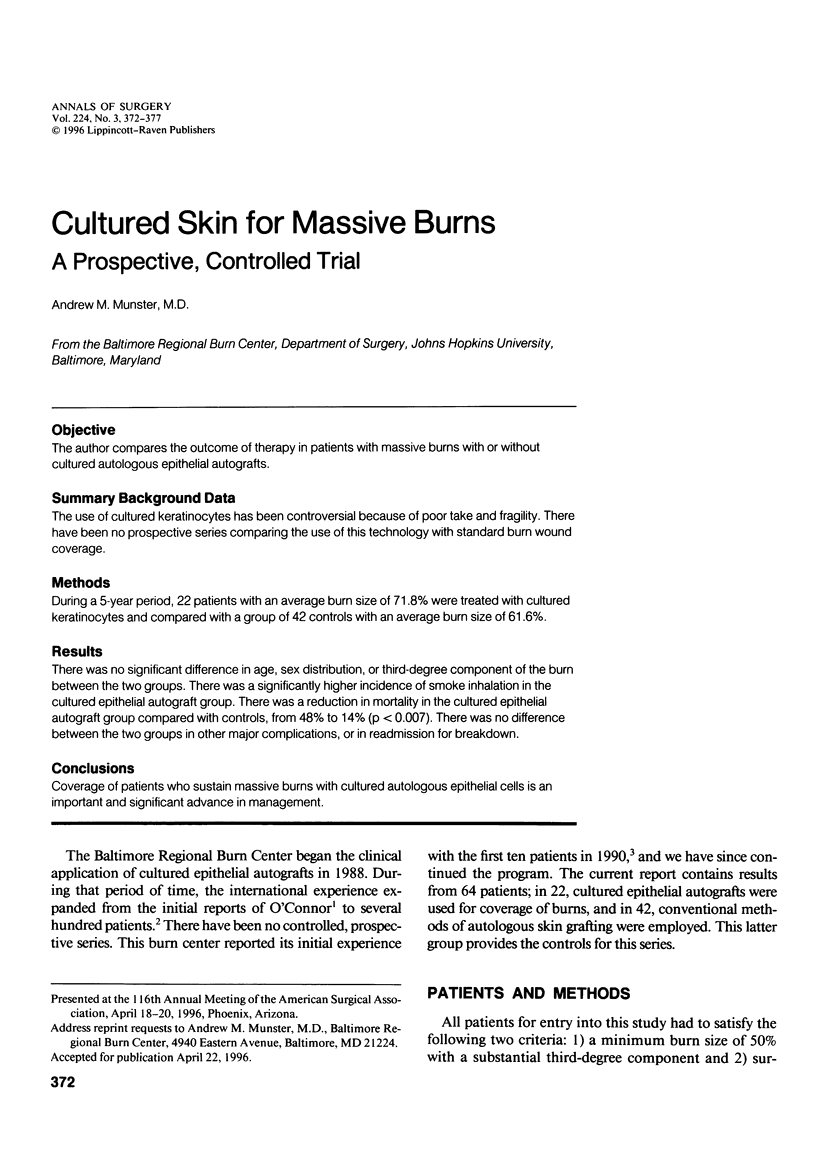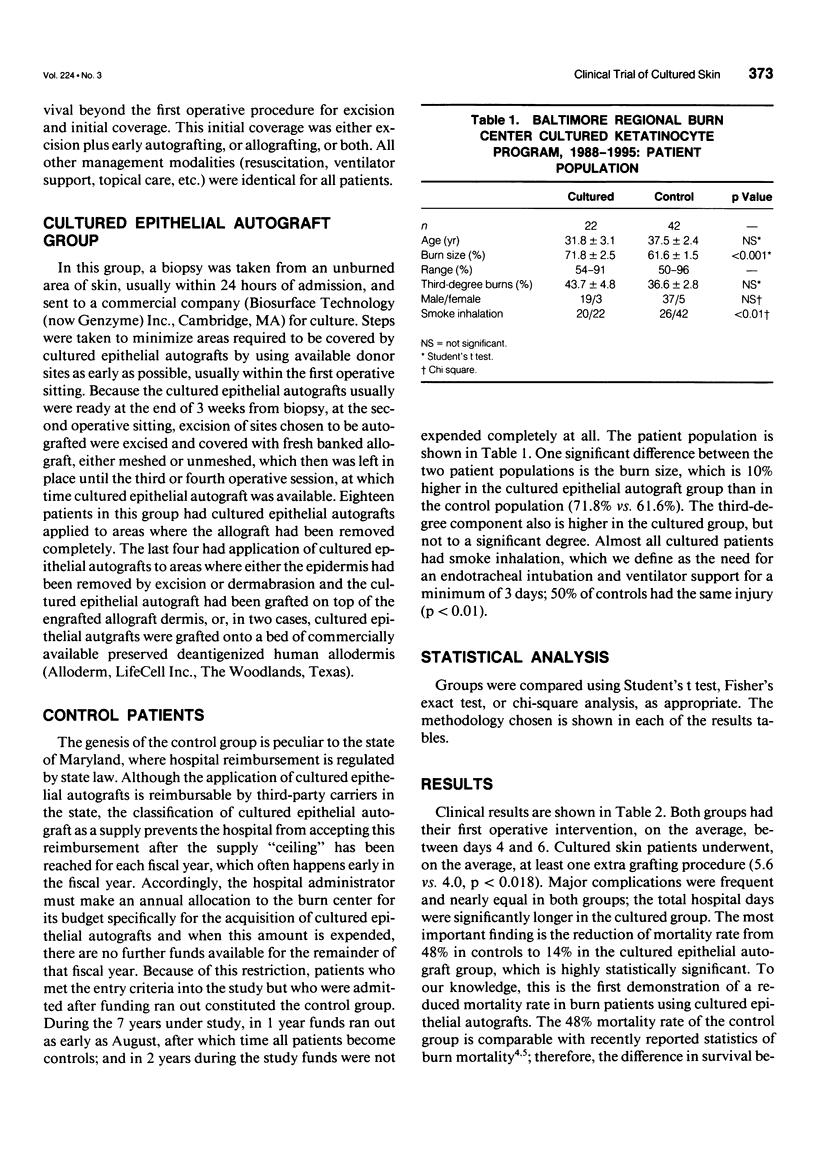Abstract
OBJECTIVE: The author compares the outcome of therapy in patients with massive burns with or without cultured autologous epithelial autografts. SUMMARY BACKGROUND DATA: The use of cultured keratinocytes has been controversial because of poor take and fragility. There have been no prospective series comparing the use of this technology with standard burn wound coverage. METHODS: During a 5-year period, 22 patients with an average burn size of 71.8% were treated with cultured keratinocytes and compared with a group of 42 controls with an average burn size of 61.6%. RESULTS: There was no significant difference in age, sex distribution, or third-degree component of the burn between the two groups. There was a significantly higher incidence of smoke inhalation in the cultured epithelial autograft group. There was a reduction in mortality in the cultured epithelial autograft group compared with controls, from 48% to 14% (p < 0.007). There was no difference between the two groups in other major complications, or in readmission for breakdown. CONCLUSIONS: Coverage of patients who sustain massive burns with cultured autologous epithelial cells is an important and significant advance in management.
Full text
PDF



Selected References
These references are in PubMed. This may not be the complete list of references from this article.
- Blight A., Mountford E. M., Cheshire I. M., Clancy J. M., Levick P. L. Treatment of full skin thickness burn injury using cultured epithelial grafts. Burns. 1991 Dec;17(6):495–498. doi: 10.1016/0305-4179(91)90079-v. [DOI] [PubMed] [Google Scholar]
- Clugston P. A., Snelling C. F., Macdonald I. B., Maledy H. L., Boyle J. C., Germann E., Courtemanche A. D., Wirtz P., Fitzpatrick D. J., Kester D. A. Cultured epithelial autografts: three years of clinical experience with eighteen patients. J Burn Care Rehabil. 1991 Nov-Dec;12(6):533–539. [PubMed] [Google Scholar]
- Coleman J. J., 3rd, Siwy B. K. Cultured epidermal autografts: a life-saving and skin-saving technique in children. J Pediatr Surg. 1992 Aug;27(8):1029–1032. doi: 10.1016/0022-3468(92)90552-i. [DOI] [PubMed] [Google Scholar]
- Compton C. C. Current concepts in pediatric burn care: the biology of cultured epithelial autografts: an eight-year study in pediatric burn patients. Eur J Pediatr Surg. 1992 Aug;2(4):216–222. doi: 10.1055/s-2008-1063444. [DOI] [PubMed] [Google Scholar]
- Compton C. C., Hickerson W., Nadire K., Press W. Acceleration of skin regeneration from cultured epithelial autografts by transplantation to homograft dermis. J Burn Care Rehabil. 1993 Nov-Dec;14(6):653–662. doi: 10.1097/00004630-199311000-00010. [DOI] [PubMed] [Google Scholar]
- Desai M. H., Mlakar J. M., McCauley R. L., Abdullah K. M., Rutan R. L., Waymack J. P., Robson M. C., Herndon D. N. Lack of long-term durability of cultured keratinocyte burn-wound coverage: a case report. J Burn Care Rehabil. 1991 Nov-Dec;12(6):540–545. doi: 10.1097/00004630-199111000-00009. [DOI] [PubMed] [Google Scholar]
- Grafting of burns with cultured epithelium prepared from autologous epidermal cells. Lancet. 1981 Jan 10;1(8211):75–78. [PubMed] [Google Scholar]
- Haith L. R., Jr, Patton M. L., Goldman W. T. Cultured epidermal autograft and the treatment of the massive burn injury. J Burn Care Rehabil. 1992 Jan-Feb;13(1):142–146. doi: 10.1097/00004630-199201000-00032. [DOI] [PubMed] [Google Scholar]
- Hansbrough J. F., Doré C., Hansbrough W. B. Clinical trials of a living dermal tissue replacement placed beneath meshed, split-thickness skin grafts on excised burn wounds. J Burn Care Rehabil. 1992 Sep-Oct;13(5):519–529. doi: 10.1097/00004630-199209000-00004. [DOI] [PubMed] [Google Scholar]
- Henckel von Donnersmarck G., Mühlbauer W., Höfter E., Hartinger A. Die Verwendung von Keratinozytenkulturen in der Schwerbrandverletztenbehandlung--bisherige Erfahrungen, Ausblicke zur weiteren Entwicklung. Unfallchirurg. 1995 Apr;98(4):229–232. [PubMed] [Google Scholar]
- McAree K. G., Klein R. L., Boeckman C. R. The use of cultured epithelial autografts in the wound care of severely burned patients. J Pediatr Surg. 1993 Feb;28(2):166–168. doi: 10.1016/s0022-3468(05)80266-0. [DOI] [PubMed] [Google Scholar]
- Munster A. M., Weiner S. H., Spence R. J. Cultured epidermis for the coverage of massive burn wounds. A single center experience. Ann Surg. 1990 Jun;211(6):676–680. doi: 10.1097/00000658-199006000-00005. [DOI] [PMC free article] [PubMed] [Google Scholar]
- Odessey R. Addendum: multicenter experience with cultured epidermal autograft for treatment of burns. J Burn Care Rehabil. 1992 Jan-Feb;13(1):174–180. [PubMed] [Google Scholar]
- Reig A., Tejerina C., Baena P., Mirabet V. Massive burns: a study of epidemiology and mortality. Burns. 1994 Feb;20(1):51–54. doi: 10.1016/0305-4179(94)90106-6. [DOI] [PubMed] [Google Scholar]
- Rue L. W., 3rd, Cioffi W. G., Mason A. D., McManus W. F., Pruitt B. A., Jr Improved survival of burned patients with inhalation injury. Arch Surg. 1993 Jul;128(7):772–780. doi: 10.1001/archsurg.1993.01420190066009. [DOI] [PubMed] [Google Scholar]
- Sheridan R. L., Tompkins R. G. Cultured autologous epithelium in patients with burns of ninety percent or more of the body surface. J Trauma. 1995 Jan;38(1):48–50. doi: 10.1097/00005373-199501000-00014. [DOI] [PubMed] [Google Scholar]
- Still J. M., Jr, Orlet H. K., Law E. J. Use of cultured epidermal autografts in the treatment of large burns. Burns. 1994 Dec;20(6):539–541. doi: 10.1016/0305-4179(94)90017-5. [DOI] [PubMed] [Google Scholar]


